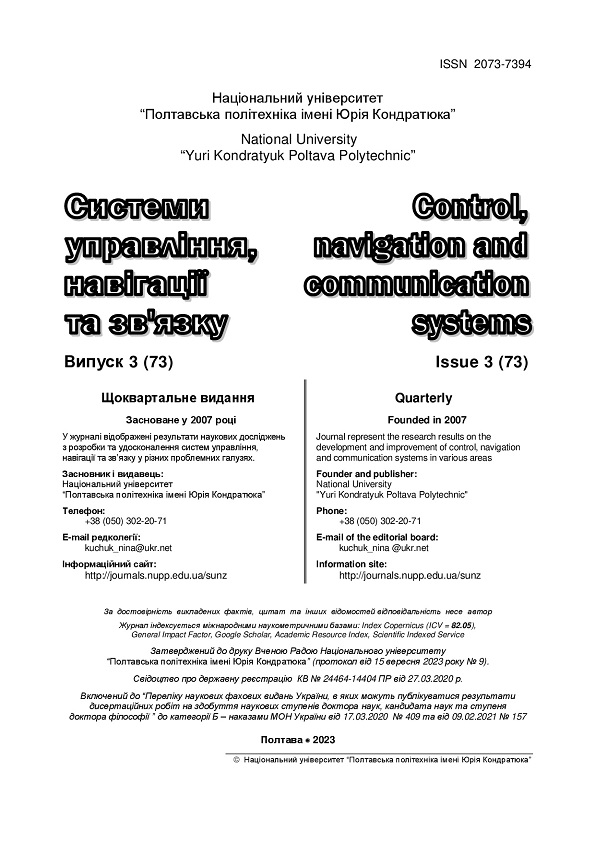ВИКОРИСТАННЯ РОЗПІЗНАНОЇ ЕМОЦІЇ ЯК НЕЯВНОГО ФІДБЕКУ ДЛЯ РЕКОМЕНДАЦІЙНОЇ СИСТЕМИ
DOI:
https://doi.org/10.26906/SUNZ.2023.3.115Ключові слова:
глибока нейронна мережа з шарами занурення, extended reality, імерсивність, 3D згорткова нейронна мережа ВАнотація
Актуальність. Через зростання цифровізації мистецтва постають задачі покращення імерсивності під час взаємодії користувача з системами extended reality мистецтвом. Методи дослідження. Глибока нейронна мережа з шарами занурення, 3D згорткова нейронна мережа. Мета статті: Покращення відбору найбільш релевантних відео за допомогою використання розпізнаних емоцій користувача як неявного фідбеку в рекомендаційній системі віртуальних арт-композицій. Отримані результати. Було розроблено систему для класифікації емоцій користувача на відео, подальшої калькуляції емоційного скорингу та використанні отриманого значення в якості неявного фідбеку для рекомендаційної системи відбору найбільш релевантних відео для створення віртуальних арт композицій. Поєднання представлених методів дозволить покращити персоналізації рекомендацій та її збільшити імерсивність час взаємодії користувача з віртуальними арт-композиціями. Висновок. Розроблений у роботі підхід може бути використаний для покращення імерсивності та персоналізації рекомендацій під час взаємодії користувача з системами extended reality мистецтвом.Завантаження
Посилання
F. Ye, "Image Art Innovation based on Extended Reality Technology," 2022 7th IEEE International Conference on Data Science in Cyberspace (DSC), Guilin, China, 2022, pp. 584-587, doi: 10.1109/DSC55868.2022.00087.
Gironacci, Irene. (2021). State of the Art of Extended Reality Tools and Applications in Business. 10.4018/978-1-7998-4339-9.ch008.
Caarls, Jurjen & Jonker, Pieter & Kolstee, Yolande & Rotteveel, Joachim & Eck, Wim. (2009). Augmented Reality for Art, Design and Cultural Heritage—System Design and Evaluation. EURASIP J. Image and Video Processing. 2009.10.1155/2009/716160.
Lai, Chi-Hui & Chen, Chun-Chih & Wu, Shu-Ming. (2023). Analysis of Key Factors for XR Extended Reality Immersive Art Experience. International Journal of Social Sciences and Artistic Innovations. 3. 24-36. 10.35745/ijssai2023v03.01.0004.
Wang, Fei. (2023). Research on the application of immersive art in digital technology scene. Advances in Education, Humanities and Social Science Research. 5. 88. 10.56028/aehssr.5.1.88.2023.
Zhang, Ying. (2023). Immersive Multimedia Art Design Based on Deep Learning Intelligent VR Technology. Wireless Communications and Mobile Computing. 2023. 1-8. 10.1155/2023/9266522.
Ha, Taejin & Kim, Yeongmi & Ryu, Jeha & Woo, Woontack. (2006). Enhancing Immersiveness in AR-Based Product Design. 4282. 207-216. 10.1007/11941354_22.
Kuliahin, A. & Narozhnyi, V. & Tkachov, V. & Kuchuk, H.. (2022). Study of methods of building recommendation system for solving the problem of selecting the most relevant video when creating virtual art compositions. Control, navigation and communication systems. Collection of scientific papers. 4. 94-99. 10.26906/SUNZ.2022.4.094.
Zhao, Qian & Harper, Franklin & Adomavicius, Gediminas & Konstan, Joseph. (2018). Explicit or implicit feedback? engagement or satisfaction?: a field experiment on machine-learning-based recommender systems. SAC '18: Proceedings of the 33rd Annual ACM Symposium on Applied Computing. 1331-1340. 10.1145/3167132.3167275.
Yang, Zhen. (2022). Research on Personalized Product Recommendation Algorithm for User Implicit Behavior Feedback.10.1007/978-981-19-6901-0_149.
Hu, Yifan & Koren, Yehuda & Volinsky, Chris. (2008). Collaborative Filtering for Implicit Feedback Datasets. Proceedings - IEEE International Conference on Data Mining, ICDM. 263-272. 10.1109/ICDM.2008.22.
Zhao, Jianfeng & Mao, Xia & Zhang, Jian. (2018). Learning deep facial expression features from image and optical flow sequences using 3D CNN. The Visual Computer. 34. 10.1007/s00371-018-1477-y.
D. Tran, H. Wang, L. Torresani, J. Ray, Y. LeCun and M. Paluri, "A Closer Look at Spatiotemporal Convolutions for Action Recognition," 2018 IEEE/CVF Conference on Computer Vision and Pattern Recognition, Salt Lake City, UT, USA, 2018, pp. 6450-6459, doi: 10.1109/CVPR.2018.00675.
Umer, Saiyed & Rout, Ranjeet & Hossain, Sanoar & Asari, Vijayan. (2021). A Unified Framework of Deep Learning-Based Facial Expression Recognition System for Diversified Applications. Applied Sciences. 11. 10.3390/app11199174.
Zadeh, A., Liang, P.P., Poria, S., Vij, P., Cambria, E., & Morency, L.P. (2016). CMU-MOSI Dataset (Version 1.0) [Data set]. CMU Multimodal SDK. http://multicomp.cs.cmu.edu/resources/cmu-mosi-dataset/.




